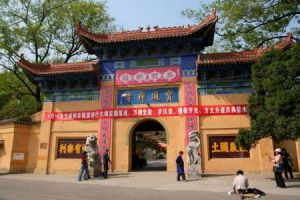Baotong Si
The Baotong Si (Baotong Temple), situated on the southern side of the Hongshan Mountain of Wuchang, was originally known as Dongshi Ting (Eastern Rock Pavilion) when it was built during the Zhenguan reign (627-649) of the Tang Dynasty. It was expanded and renamed Chongning Wanshou Si during the Song Dynasty (960-1279), only to be reduced to a pile of ruins during war in 1356, or the 16th year of the Zhizheng reign of the Yuan Dynasty. It was rebuilt during the Ming Dynasty (1368-1644) and then assumed its present name, Baotong Temple. The Hall of 500 Arhats was added to it during repairs done to the temple in 1638 (11th year of the Chongzhen reign, Ming Dynasty). Its heyday came during the Yongzheng reign (1723-1735) of the Qing Dynasty, when the temple had a total population of 1,500 monks, its territory covered an area five km in circumference, and emerged as a gigantic complex of six major halls, a hundred other buildings, and 12 meditation chambers. But all these existed no more, following an attack on Wuchang by the army of the Taiping Heavenly Kingdom. In the ensuing years the temple was rebuilt and gradually grew in size. Though it has never attained the apex of its former grandeur, the temple eventually reestablished itself as a major Buddhist center and became the site of the Wuchang Buddhist Seminary.
The buildings on the premises today are a legacy of the Guangxu reign (1875-1908) of the Qing Dynasty. Standing on the mountain behind the temple is the Baotong Pagoda, also known as the “Hongshan Precious Pagoda.” A 45.6-m-high seven-tiered octagonal structure with a masonry interior and an exterior built of stone and brick, it was built in 1270 (7th year of the Zhiyuan reign, Yuan Dynasty), and rebuilt in 1332 (3rd year of the Zhishun reign, Yuan Dynasty). Access to the top of the pagoda is by a staircase built inside, which commands an all-encapsulating view of the tripartite city of Wuhan.
